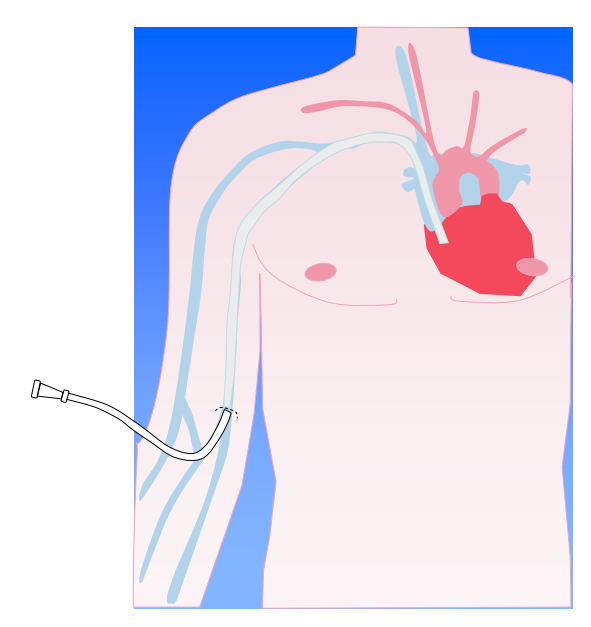Peripherally Inserted Central Catheter
A peripherally inserted central catheter (PICC) is a fine, long plastic tube that is inserted into a vein in your upper arm and is then threaded up inside the vein. The end of the line will sit in a large blood vessel in your chest. The PICC will be used to give you intravenous treatments and for blood tests to be taken. The PICC can stay in for several weeks or months if required.
An experienced nurse from the hospital will insert your PICC on one of the hospital wards. The procedure only takes 30 minutes to an hour but if you are having the procedure as a day case, you will need to plan on being with us for about two hours. This will allow us time to tell you all about the line and how to look after it.

How is the PICC line inserted?
The nurse/doctor will explain the procedure to you, including the benefits and risks, and allow time for you to ask questions. You will be asked to give your consent to the procedure.
You will be asked to lay flat on the bed or couch with one pillow only. The nurse/doctor will position your arm at a right angle so that he/she can access your upper arm easily.
The nurse/doctor may choose to use an ultrasound machine to help visualise the veins in your arm more clearly. The nurse will prepare the equipment; wash his/her hands and put on a surgical gown and gloves. This is to minimise the risk of bacteria being spread during the procedure.
After injecting some local anaesthetic into the skin, a needle, followed by a fine guide wire and then a plastic tube called an introducer will be inserted into the vein in your upper arm. The nurse/doctor will then remove the guide wire and thread the PICC through the introducer into the vein. Once the PICC has been inserted to the correct length, the introducer is removed and some adhesive dressings will be applied to the PICC to secure it in position.
If you have had your PICC inserted on the ward, you will need to have a chest x-ray after the PICC has been inserted so that the nurse or doctor can check whether or not it is in the correct position. This will not be necessary if the PICC is inserted in the Radiology Department.
Benefits of a PICC
- allow fast and reliable access for intravenous injections and infusions, chemotherapy, blood transfusions and for blood tests
- probably more comfortable than frequent blood tests and repeated insertion of cannulas
- occasionally essential for the administration of certain medicines
- can stay in place for many months.
Risk associated with a PICC
Incorrect position of PICC: On occasion, the end of the PICC does not sit in the best possible place in the vein and this may require it to be reinserted
Nerve pain: Although very rare, you could experience sudden pain in your arm or hand during the insertion procedure. If this occurs, the nurse will remove the needle which should quickly resolve the problem
Cardiac arrhythmias: If the PICC is inserted too far, it could cause your heart to beat faster than usual causing you to feel palpitations (a fluttery feeling). If this occurs, the PICC will be withdrawn slightly, after which the symptoms should stop
Thrombosis: You are at risk of developing a thrombosis (clot) around or near to the PICC. Symptoms include pain in your arm, shoulder or chest, swelling of the arm or altered colour of the arm
Mechanical phlebitis: You may develop some redness and tenderness along the skin above where the PICC has been inserted. This can easily be treated
Infection: You could develop an infection at the site where the PICC has entered the skin or inside the PICC. Symptoms include redness and/or pus at the site of the PICC or and having a high temperature, and/or flu-like symptoms
Movement of PICC: If you pull the PICC, it could come out, either partially or fully. It is not stitched in place so care must be taken not to pull the PICC
If you experience any of the symptoms described, or any other problems with your PICC, you should immediately tell the nurse caring for you or contact the hospital if you are at home.
Who to contact
If you have a problem or concern about any aspect of your PICC, please contact a member of the hospital team looking after you.
They can be contacted on the number below:
Name: ………………………………………………………………………………..
Telephone: …………………………………………………………………………..
About this leaflet
Author: Abigail Orchard, Lead Cancer Nurse
Written: March 2015
Updated and approved: March 2020
Review date: March 2023
Edition: 2
If you have feedback regarding the accuracy of the information contained in this leaflet, or if you would like a list of references used to develop this leaflet, please email patientinformation.leaflets@dchft.nhs.uk
Print leaflet